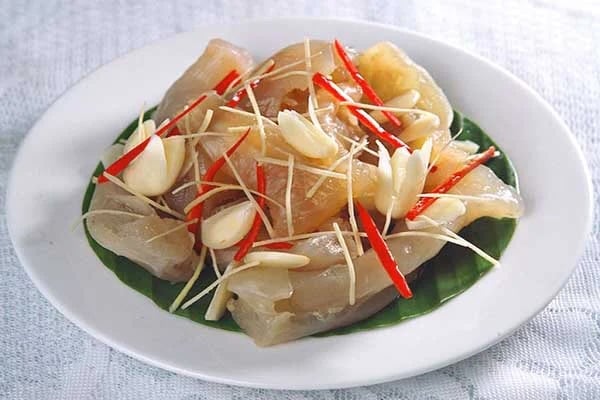
The Main Types of Beef Tendons
The first is the inner tendon, taken from the core of the shank, and is considered the most delicious due to its tenderness and flavor. The second type is the golden tendon, cut along the bone, usually found in the shoulder area. This type is favored by new mothers for its ability to stimulate milk production. Lastly, there’s the tendon with meat attached, found under the thigh, often used in dishes like beef noodle soup, pho, or beef stew.
Despite being significantly cheaper than beef (<$5-7/kg compared to $9-13/kg for beef), beef tendons are nutrient-dense, earning the title of "top-quality ginseng from hoofed animals." They are composed mainly of collagen (up to 42%), protein, and fat, along with essential micronutrients like zinc, magnesium, iron, and vitamins.
According to Mr. Hoan, a beef seller at Ha Dong Market in Hanoi, Vietnam, "Beef usually sells out by noon, but tendons are rare, and only early morning shoppers have a chance to buy them. I can only get a small amount of tendon from half a cow, and most of it is pre-ordered." Despite some considering beef tendons less tasty than regular beef, they are actually quite popular with homemakers, adding variety to family meals. With their crunchy texture and lack of an unpleasant odor, beef tendons have become a common choice.

A Rare Treat: Beef Tendons
Today, beef tendons are not only enjoyed in home-cooked meals but are also favored by restaurants and eateries. Here are some delicious dishes featuring beef tendons:
– **Beef Tendon with King’s Herb**: A simple yet delightful dish combining beef tendons with dried king’s herb, garlic, chili, and ginger. It’s a common treat during the Tet Holiday, adding variety to the festive feast.

Beef Tendon with Garlic
– **Beef Tendon in Wine Sauce**: This dish is a harmonious blend of aromatic spices like star anise and cardamom with the subtle sweetness of wine. The tendons are braised with carrots, potatoes, and onions and can be enjoyed with rice, noodles, or bread.
– **Beef Tendon Braised with Chinese Herbal Medicine**: A nourishing dish perfect for those with delicate health. The unique fragrance of Chinese herbal medicine combines with the tender beef tendons, making it an ideal comfort food during cold winter days.
There you have it! Beef tendons offer a delicious and nutritious option, adding a crunchy texture to your meals. With their growing popularity, they are now a sought-after delicacy, offering a unique culinary experience.































